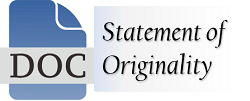DEDIAVER Sebagai Aplikasi Alternatif Tes Denver II untuk Tes Deteksi Dini Perkembangan Anak
DOI:
https://doi.org/10.31599/pratb211Keywords:
child development, application evaluations, DEDIAVER, Denver II TestAbstract
One of the focuses of research and innovation in Indonesia is to encourage the development of health resilience and independence, and one of the concerns is child development. According to the Indonesian Pediatrician Association (IDAI), about 5-10% of children are estimated to have developmental delays and around 1-3% under the age of 5 years experience general developmental delays. Early Detection of Child Development Based on the Denver II Test (DEDIAVER) is a decision support system (DSS) application that can be used to detect child development using the Denver II Test instruments. This research aims to evaluate the DEDIAVER application and assess the feasibility of the DEDIAVER application as an alternative application for the Denver II Test for early detection tests of child development. The test is carried out by matching the results of the Denver II Test, which is carried out manually, with the results of the DEDIAVER application. As a result, for the test for children aged 0-2 years, the total accuracy for each developmental sector and age is 90.67%, while the test for children aged 2-6 years has an accuracy of 36%. The accuracy of the test for ages 2-6 years is only 36% due to the difference in the application's age calculation, which is 4-6 months older than the actual age. The age difference causes the questions for children over their age to be questioned.
Downloads
References
Badan Pusat Statistik. (2020). Analisis Perkembangan Anak Usia Dini Indonesia 2018 – Integrasi Susenas dan Riskesdas 2018. https://www.bps.go.id/publication/2020/10/22/7318afd993e5483a36649b4d/analisis-perkembangan-anak-usia-dini-indonesia-2018-integrasi-susenas-dan-riskesdas-2018.html
Badan Riset dan Inovasi Nasional. (2021). Dorong Ketahanan dan Kemandirian Kesehatan, Menristek/ Kepala BRIN: Sinergi Triple Helix Kunci Transformasi Ekonomi – BRIN. https://www.brin.go.id/dorong-ketahanan-dan-kemandirian-kesehatan-menristek-kepala-brin-sinergi-triple-helix-kunci-transformasi-ekonomi/
Bertl, M., Ross, P., & Draheim, D. (2022). A survey on AI and decision support systems in psychiatry – Uncovering a dilemma. Expert Systems with Applications, 202, 117464. https://doi.org/10.1016/J.ESWA.2022.117464
Gumiri, V. L., Puspitaningrum, D., & Ernawati. (2015). Sistem Pakar Klasifikasi Status Perkembangan Anak Usia Dini dengan Metode Naive Bayes Classifer Berbasis DDST Rules. Jurnal Rekursif, 3(2), 107–122. https://ejournal.unib.ac.id
Ivantoni, R., & Muhimmah, I. (2015). Aplikasi Penentuan Tingkat Tumbuh Kembang Anak Menggunakan Tes Denver II. Seminar Nasional Informatika Medis (SNIMed) VI, 124–132.
Kurniawan, R., Muhimmah, I., & Roichatul Jannah, H. (2016). Sistem Monitoring Perkembangan Anak Berbasis Denver Development Screening Test (DDST / Denver II). Teknoin, 22(4), 305–314. https://doi.org/10.20885/teknoin.vol22.iss4.art8
Kurniawati, Y. E., & Prabowo, Y. D. (2021). Decision Support System to Measure Child Development Based on Denver II using Naïve Bayes Classifier. 2021 International Conference on Data and Software Engineering (ICoDSE), 1–6. https://doi.org/10.1109/ICoDSE53690.2021.9648427
Kurniawati, Y. E., Saptono, R., & Salamah, U. (2013). Alat Bantu Penentu Fase Tumbuh Kembang Anak Berdasarkan Instrumen Tes Denver II Menggunakan Metode Naïve Bayes Classifier [Universitas Sebelas Maret]. https://digilib.uns.ac.id/dokumen/detail/29455/Alat-Bantu-Penentu-Fase-Tumbuh-Kembang-Anak-Berdasarkan-Instrumen-Tes-Denver-Ii-Menggunakan-Metode-Naïve-Bayes-Classifier
Lopez Boo, F., Cubides Mateus, M., & Llonch Sabatés, A. (2020). Initial psychometric properties of the Denver II in a sample from Northeast Brazil. Infant Behavior and Development, 58(January 2019), 101391. https://doi.org/10.1016/j.infbeh.2019.101391
Newaz, A., Muhtadi, S., & Haq, F. S. (2022). An intelligent decision support system for the accurate diagnosis of cervical cancer. Knowledge-Based Systems, 245, 108634. https://doi.org/10.1016/J.KNOSYS.2022.108634
Nugroho, H. S. W. (2009). Petunjuk Praktis Denver Developmental Screening Test. EGC.
Park, Y., Bang, Y., & Kwon, J. (2022). Clinical decision support system and hospital readmission reduction: Evidence from U.S. panel data. Decision Support Systems, 159, 113816. https://doi.org/10.1016/J.DSS.2022.113816
Rakhmawati, E., Martiana, E., & Mubtadai, N. R. (2013). Diagnosa Keterlambatan Perkembangan Pada Anak Balita dengan Acuan Denver II dan Pengambil Keputusan dengan Metode JSP. Institut Teknologi Sepuluh Nopember.
Sprague, R. H. (1980). A framework for the development of decision support systems. MIS Quarterly: Management Information Systems, 4(4), 1–26. https://doi.org/10.2307/248957
Sreejith, S., Khanna Nehemiah, H., & Kannan, A. (2022). A clinical decision support system for polycystic ovarian syndrome using red deer algorithm and random forest classifier. Healthcare Analytics, 2, 100102. https://doi.org/10.1016/J.HEALTH.2022.100102
Thor Olavsrud. (2020). Decision support systems: Sifting data for better business decisions | CIO. https://www.cio.com/article/3545813/decision-support-systems-sifting-data-for-better-business-decisions.html
Troy Segal. (2022). Decision Support System (DSS): What It Is and How Businesses Use Them. https://www.investopedia.com/terms/d/decision-support-system.asp
Turban, E., Sharda, R., & Delen, D. (2011). Decision Support and Business Intelligence Systems (Ninth). Pearson Education.
United Nations. (2022). Sustainable Development Goals | United Nations in Indonesia. https://indonesia.un.org/en/sdgs
Venancio, S. I., Buccini, G. S., Alves, C. R. L., Bortoli, M. C., Bernal, R. T. I., Eickmann, S. H., Frias, P. G., Giugliani, E. R. J., & Santos, M. O. (2021). Psychometric properties of the Child Development Assessment Questionnaire (QAD-PIPAS) for use in population studies involving Brazilian children aged 0–59 months. Jornal de Pediatria. https://doi.org/10.1016/j.jped.2021.01.003











_-_Copy1.jpg)




